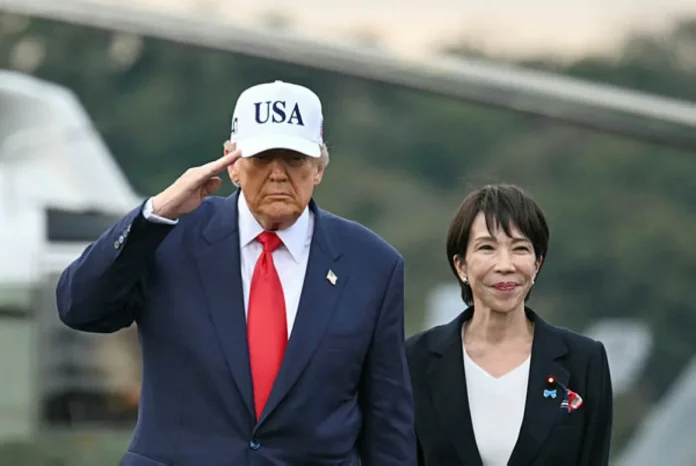TOKYO: Japan’s new Prime Minister Sanae Takaichi and US President Donald Trump exchanged mutual praise while pledging a new golden age for their countries’ alliance during Trump’s visit to Tokyo.
Takaichi, Japan’s first woman prime minister, hosted Trump at the Akasaka Palace state guest house in her first major international test since taking office.
The White House announced that Takaichi would nominate Trump for a Nobel Peace Prize during their meeting.
Trump responded by calling it a great honour to meet Takaichi so early in what he predicted would be one of the greatest prime ministerships.
He declared that Washington remained Japan’s ally at the strongest possible level.
Takaichi specifically praised Trump’s efforts toward a ceasefire between Thailand and Cambodia and his unprecedented historic achievement with the Gaza deal.
She expressed her desire to realise a new golden age of the Japan-US Alliance where both nations would become stronger and more prosperous.
The two leaders signed an agreement focused on achieving resilience and security in critical minerals and rare earths supply chains.
This deal comes after Beijing announced sweeping restrictions on the rare earths industry earlier this month.
Trump subsequently threatened 100% tariffs on imports from China in retaliation for these restrictions.
Following his meeting with Takaichi, Trump met with families of Japanese citizens abducted by North Korea decades ago.
He assured the families that the United States stood with them all the way in their search for loved ones.
North Korea admitted in 2002 that it had sent agents to kidnap 13 Japanese people to train spies in Japanese language and customs.
Japan maintains that North Korea abducted additional citizens beyond those officially acknowledged.
Trump arrived in Tokyo on Monday between visits to Malaysia and an upcoming meeting with Chinese counterpart Xi Jinping in South Korea.
Negotiators from both Beijing and Washington have confirmed agreeing on a framework between the world’s two largest economies.
Security and trade between their allied countries formed the expected focus of Trump and Takaichi’s discussions.
Tokyo resident Takashi Ito emphasised the importance of finding some middle ground on trade issues.
He noted that simply pushing to raise tariffs had already created various problems for both nations.
Japan is adopting a more muscular military stance as relations with China worsen despite its long-pacifist tradition.
Takaichi confirmed her government would achieve its target of spending 2% of gross domestic product on defence this year, two years ahead of schedule.
The United States wants Japan to spend even more, potentially matching the 5% of GDP pledged by NATO members in June.
University of Tokyo professor Yee Kuang Heng suggested Takaichi preemptively brought forward the defence spending target to deflect US pressure for further increases.
Trump’s schedule included delivering a speech aboard the USS George Washington aircraft carrier docked at Yokosuka naval base.
He also planned to have dinner with business leaders, likely including Toyota’s chairman.
Most Japanese imports into the United States currently face 15% tariffs, less severe than initially threatened 25% rates.
These levies contributed to a 24% slump in US-bound car exports by value in September compared to the previous year.
Japan’s car industry accounts for approximately 8% of the country’s jobs.
Under a July trade deal shared by the White House, Japan is expected to invest 550 billion dollars in the United States.
Takaichi works to establish a strong relationship with Trump, who had close personal ties with assassinated former premier Shinzo Abe.
Abe’s alleged killer Tetsuya Yamagami awaits trial in Nara, which also happens to be Takaichi’s hometown.
The potential China trade deal remains the greatest prize for both Trump and global markets.
Trump will meet Xi on Thursday in South Korea for their first face-to-face talks since the Republican’s return to office in January. – AFP











